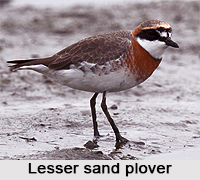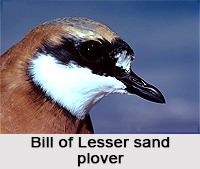 Lesser sand plover is an Indian Bird that bears a scientific name "Charadrius mongolus" is a small wader in the plover family of birds.
Lesser sand plover is an Indian Bird that bears a scientific name "Charadrius mongolus" is a small wader in the plover family of birds.
Races of Lesser sand plover
There are five races of Lesser sand plover, and the large east Asian forms, C. m. mongolus and C. m. stegmanni, are sometimes given specific status as Mongolian plover, Charadrius mongolus. If the taxonomic split is accepted, lesser sand plover as then defined becomes Charadrius atrifrons, including the three races atrifrons, pamirensis and schaeferi.
Breeding Season of Lesser sand plover
Lesser sand plover breeds above the tree line in the Himalayan Mountain Range and discontinuously across to bare coastal plains in north-eastern Siberia, with the Mongolian plover in the eastern part of the range. Lesser sand plover has also bred in Alaska. It nests in a bare ground scrape, laying three eggs. This species is strongly migratory, wintering on sandy beaches in east Africa, south Asia and Australasia. It is a very rare vagrant in Western Europe, but, surprisingly, of the three individuals recorded in Great Britain up to 2003, one was a Mongolian plover.
Structure of Lesser sand plover
Lesser sand plover is long-legged and long-billed. The breeding male Lesser sand plovers have grey backs and white underparts. The breast, forehead and nape are chestnut, and there is a black eye mask. The female Lesser sand plover is duller, and winter and juvenile birds lack the chestnut, apart from a hint of rufous on the head. Legs are dark and the bill black. In all plumages, this species is very similar to greater sand plover, Charadrius leschenaultii. Lesser sand plover is separating from the species may be straightforward in mixed wintering flocks on an Indian beach, where the difference in size and structure is obvious; it is another thing altogether to identify a lone vagrant to western Europe, where both species are very rare.
Prey of Lesser sand plover
Lesser sand plover takes the foods like the insects, crustaceans and annelid worms, which are obtained by a run-and-pause technique, rather than the steady probing of some other wader groups. This species takes fewer steps and shorter pauses than the greater sand plover when feeding. The flight call is a hard trill.
 Sizes of Lesser sand plover
Sizes of Lesser sand plover
The size of Lesser sand plover is one of the factors distinguishing a lesser sand plover from a greater sand plover, with the lesser being slightly smaller. However, it is not easy to rely on size alone especially when seen individually.
Bill of Lesser sand plover
The length of the bill is another distinguishing feature, with the lesser generally having a shorter bill compared to a greater.
Colour of Lesser sand plover
The colour of the legs in lesser sand plover is generally darker, ranging from black to grey, while in a greater sand plover it is much paler, ranging from grey to yellowish.



















